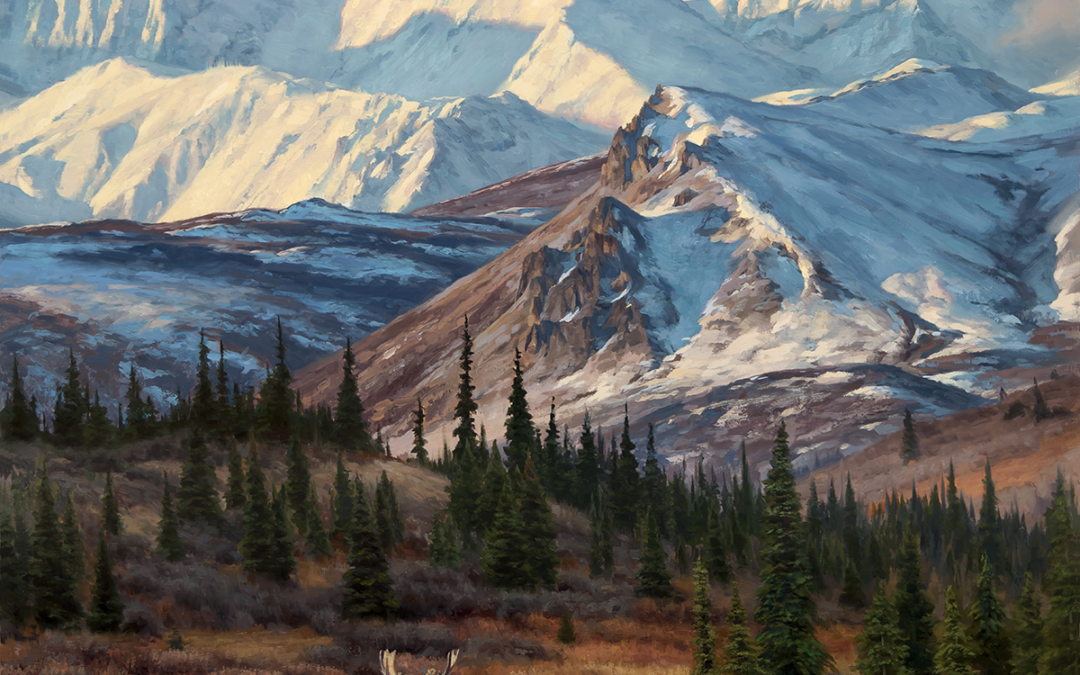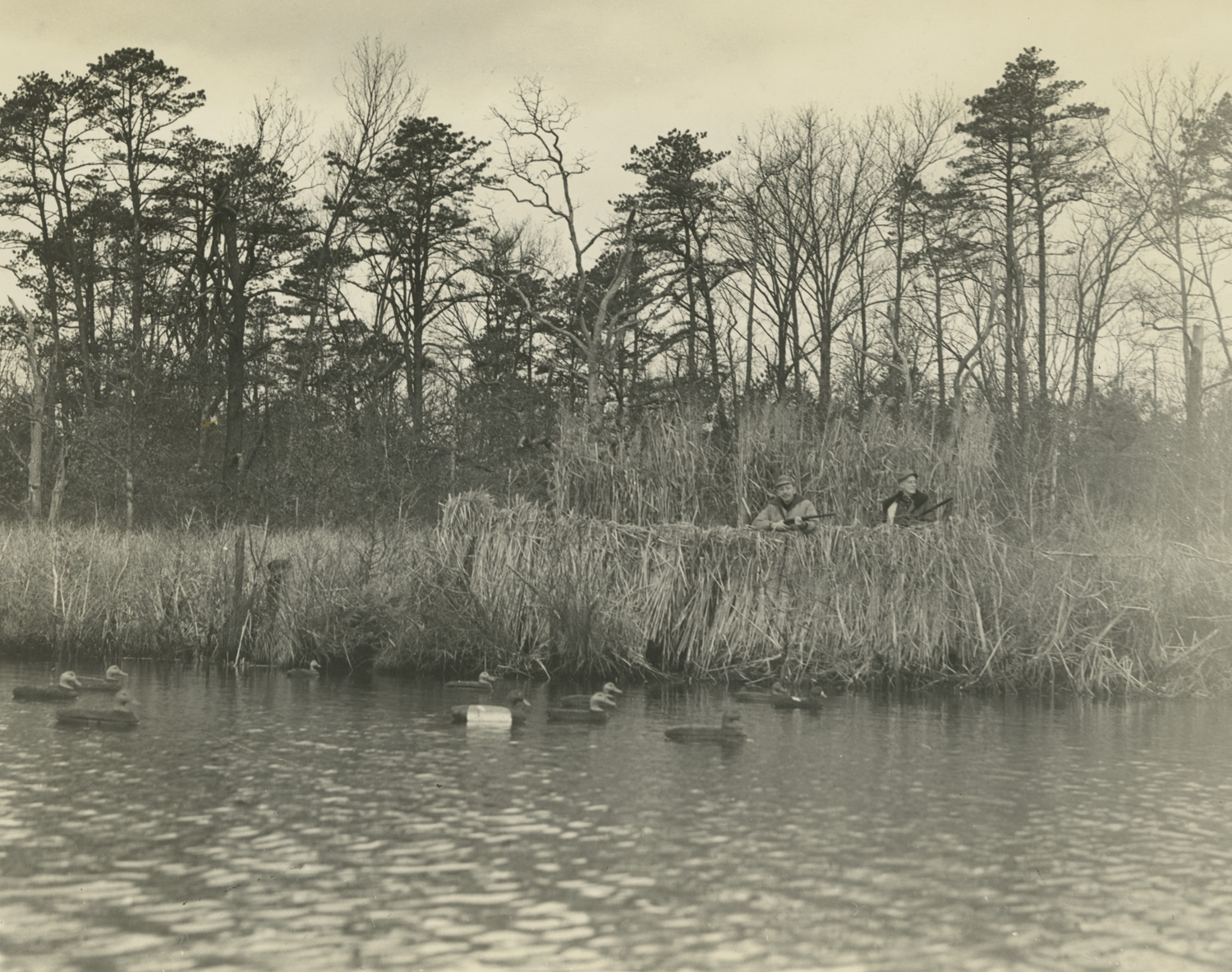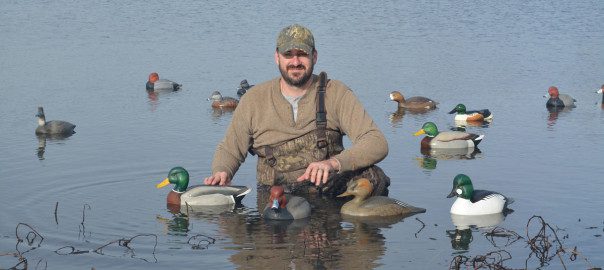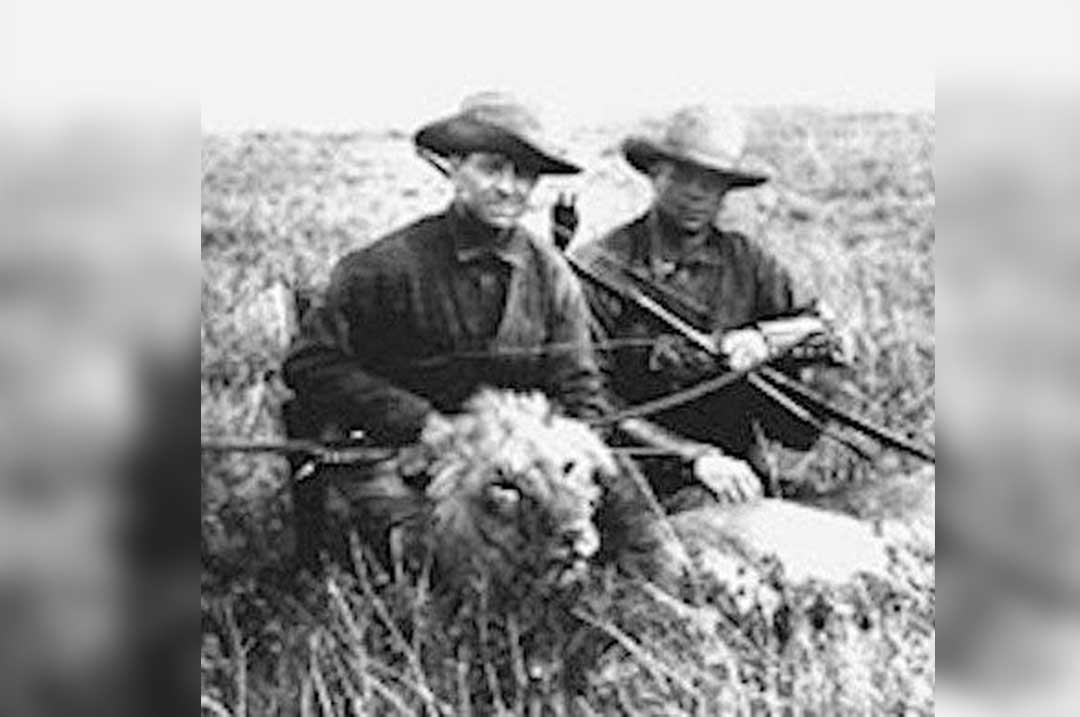In Dustin Van Wechel’s bold and rangy bison scene, the title he selected sounds as if it could have been muttered by the curmudgeonly Clint Eastwood character in the movie Gran Torino. “Get Off My Lawn” depicts a one-ton bull scattering a pair of mischievous coyotes that invaded his space. Flowing forth right at us, over us, and through us—with a charge seeming imminent—is a burst of color and action. 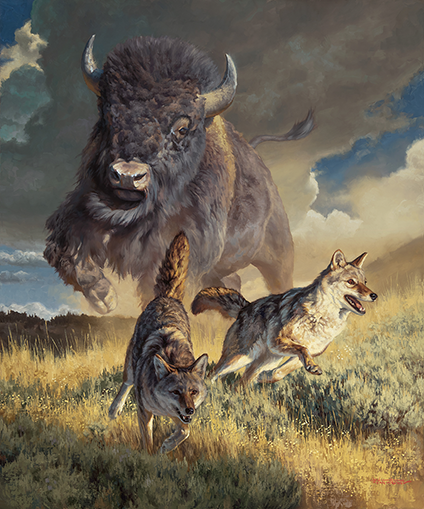
Visual impact is Van Wechel’s signature—the kind of dramatic statement for which this American painter now in the prime of his career has become known. And it is why Van Wechel, 45, is part a new vanguard declaring that wildlife art in the 21st century is not the same that decorated the rooms at grandma and grandpa’s house.
In August 2020, despite the interruption of travel that has come with Covid-19, Trailside Gallery in Jackson Hole, Wyoming, is featuring Van Wechel in a much-anticipated one-man show of new works, Visions of the Great North, inspired by a research trip he took to Alaska.
“We’re excited and so are the people who avidly follow him,” says Joan Griffith, Trailside’s gallery director. “While many are familiar with Dustin’s portrayals of big game in the Rockies and American West, this group of paintings focuses on animals in the Far North and the rugged supersized landscapes they inhabit.”
From Alaskan moose to brown bears and Dall sheep to mountain goats and caribou, Van Wechel shines once again with compositions possessing intriguing visual designs and action narratives.
“There are a lot of very good wildlife painters in today’s art market but there are two things that really set Dustin’s art apart from his peer group,” Griffith says. “One would be his play with light that calls attention to the work. Another is the kinetic energy that is present in his animals. These are not classic wildlife poses. Even if he has portrayed a subject before, he finds new ways of interpretation. For an artist that’s hard to do.”
Born in 1974, he was raised in metropolitan Phoenix. “I have a lot of influences on my work. Obviously, there have been people like Carl Rungius and Bob Kuhn and some of the other titans of wildlife art. But probably more importantly the biggest influences happened when I was young and were some of the painters of science fiction and fantasy scenes,” he says. “They were very good at conveying moods and taught me how to handle shadows, which I love to do today.”
In the Sonoran Desert, Van Wechel was situated near some of the greatest Western artists of the day who had worked as illustrators on the East Coast and retired to Tucson as well as galleries in Scottsdale that sold their work. “I wasn’t introduced to the fine artist of the Western art world until I was in my late teens and first entered Legacy Gallery in Scottsdale. The experience sort of blew my mind. I had never seen originals like that outside of a museum. I wouldn’t believe they create visions like those with paint.”
In particular, he remembers, as an 18-year-old, seeing the plein air pieces (works painted outside in the natural elements) by wildlife artist Ralph Oberg who lives today along the western slope of the Rockies. “I couldn’t believe a piece could look so realistic from five feet away but come closer and there are pieces of swishing abstract color.”
After getting an art degree in college, Van Wechel spent several years working as an illustrator and graphic artist for ad agencies in Arizona and southern California. Van Wechel toiled under quick turnaround deadlines and pressure to generate imagery that had both instant appeal and could translate a message without words attached. The schedule, he says, became a constant grind and he never had time for his own art.
“I literally one day went to my wife and said ‘I’m done with this. I want to be a painter of Western wildlife, being able to portray what I love,’” he explains. “She was supportive of me making the move and I’m lucky to be married to her because she said we’d find a way to make it happen.”
Indeed, they have, in ways few could have predicted. As fate would have it, Van Wechel’s wife, Yvonne, landed a job with an advertising firm in Nebraska where she had family and they made a move. The small city of Hastings where they settled in the south-central part of the state was well off the beaten path of the art world, but it did have a fine local gallery. Van Wechel devoted the first year to building a body of work and, interestingly, his medium was pastel.
It wasn’t until 2007 when he made a transition into oil painting. Still, after that first year in Nebraska, the local gallery owner saw some of his work and proposed a solo show and it nearly sold out. The enthusiastic reception gave him a glimpse of what was possible. “But the success also sort of gave me a false sense of what being a full-time wildlife artist would be like,” he said. “That was followed by a decade of struggle, but it reinforced the drive I needed to have.”
Van Wechel has always solicited honest critiques from artists he admires and while the suggestions aren’t always easy, his taking them to heart has been the foundation of his phenomenal growth as a talent to watch. “Dustin is an excellent drawer and he’s always pushing the envelope. What I admire about him is that he’s so committed to the often-painful process of being a better painter and in it for the long haul,” says artist Greg Beecham [whose work was featured in the May/June 2020 issue of Sporting Classics]. “As good as Dustin is, he knows he can be even better.”
Following his brief tenure in Nebraska, Dustin and Yvonne moved back to Phoenix and then, three years ago, in 2017, the couple relocated to Colorado Springs so he would have readier access to mountains and foothills where many of his wildlife subjects live.
He employs the same kind of observational skills used by hunters to identify the things worth putting into a painting. “Whenever I’m in the field, some of the moments I find most inspiring are when I just quietly observe my subject. No photographing or sketching — just taking in all of the sights, sounds and smells. These mental notes are as important to informing my work as my sketches and reference photography,” he has said. “Quietly immersing myself in the serenity of the environment often leads to unforgettable experiences with nature that I can then bring into the studio and reimagine through my work.”
“Visions of the Great North” are based on treks into the mountains around Denali National Park and along the Kenai Peninsula. Van Wechel also has a bevy of other stunning works recently completed in 2020 but not part of the Trailside Gallery show. The painting “Elevenzies” is inspired by an afternoon hike in Glacier National Park near the border of Montana and Canada. “Bighorn sheep are some of my favorite subject matter. I’ve had so many wonderful experiences hanging out them,” he says. “This scene comes from the landscape on Logan Pass and Hidden Lake Trail where the rocks are multi-colored. On this particular day, I was making sketches and the bighorns moved closer and laid down in the grass nearby.”
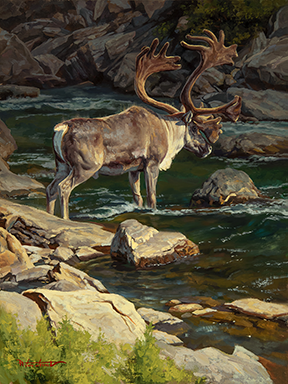 Meanwhile, another piece titled “The Savage” is set in the rugged Savage River drainage of Denali where Van Wechel observed some of the largest caribou bulls he’s ever seen. “Denali Dallings” features a family of mountain sheep on a pinnacle at dusk with the moon rising behind.
Meanwhile, another piece titled “The Savage” is set in the rugged Savage River drainage of Denali where Van Wechel observed some of the largest caribou bulls he’s ever seen. “Denali Dallings” features a family of mountain sheep on a pinnacle at dusk with the moon rising behind.
Every year Van Wechel sends about half of his new works to Trailside Gallery. In addition, he participates in the miniature show staged by Stuart Johnson at Settler’s West in Tucson and he submits pieces to the Autry in winter, the Western Visions autumn show at the National Museum of Wildlife Art, and the Buffalo Bill Center for the West Art Sale in Cody where in 2018, a piece by Van Wechel won the coveted Peoples’ Choice Award. The work, “Crossing Paths” featured a big bison bull.
Landscapes are always engaging backdrops in Van Wechel’s designs and the artist acknowledges he often wrestles with the question of whether to create a landscape painting with animals moving through it as animation or wildlife portraits filling most of the frame.
Ideas for paintings originate from all kinds of cues but mostly he has concepts involving color harmony, light and shadow relationships that are floating around in his mind and when he sees the right subjects come together with other visual elements, he builds them into a composition. “For any piece I might have done between a dozen and 20 little doodle sketches,” Van Wechel says. They are a way for previsualizing a piece and working out aspects of design that will catch the eye.
Stuart Johnson, proprietor of Settler’s West Gallery in Tucson, and a partner in orchestrating the venerable Coeur d’Alene Art Auction every summer, has handled the works of living masters and legendary deceased artists. Van Wechel fits a rare pattern of prowess he has witnessed before.
“I first started to see Dustin’s work at the Autry Museum’s Masters of the American West shows in Los Angeles and it was impressive because he approaches his subjects from a very different angle than most wildlife artists do,” Johnson says. “He brings a sense of life to the animal as opposed to replicating a photograph of an animal. He recreates it with his own style, taking it a step beyond what most artists do—just as Bob Kuhn would have done or Carl Rungius.”
The convergence of wildlife artist and collectors that happens in Jackson Hole, within the heart of the wildlife-rich Greater Yellowstone region, has been a touchstone for Van Wechel’s rise, too. “Jackson Hole is the mecca for wildlife art in America and has been for a long time, between the galleries, the major autumn art auction and the presence of the National Museum of Wildlife Art,” he says. “The animals that you see in paintings and sculptures on display actually inhabit the landscape and they are wild. One of the real delights is that a half hour after you’ve attended an exhibition at the national museum you can be sitting somewhere sketching a moose.”
Van Wechel attributes his evolution as a painter of action scenes to a couple of things. “The number one place is attempting to involve the viewer in the work. I want it to be more than just looking at an image superficially on the wall,” he explains. “Wildlife art is an oddity in the art world. With human portraits it’s easy for the viewer to connect with the subject, to have empathy, to relate to ourselves as humans. I want people to emotionally connect and to do that you can evoke drama to elicit a reaction.”
Why big game species? “They are the ones that provide my work with the most drama, these iconic creatures,” he says. “When you are out there observing them and watching 2,000-pound animals right in front of you, it’s pretty stirring.”
Along with his enigmatic placement of animal forms in the compositions, Van Wechel in recent years has been experimenting with how to enhance the textural surfaces of the work, to make them almost appear tactile like sculptures. Paintings are not meant to be touched but by stepping close and examining the abstracted brushstrokes, assiduously layered on top of one another and punctuated with highlights, one can see they possess a sort of three-dimensional topography.
Whether it’s in his work or pieces by others he admires, Van Wechel enjoys having an enhanced visual encounter. “When the viewer gets past the initial impact of subject, there’s more to be had if you zoom into the small spaces of the painting—to see how the marbling works in creating the effects of the picture as a whole.” To enhance the illusion of a painting, so that it is a melding of two dimensions bordering on three, is for Van Wechel an opportunity to add something special to his paintings.
He reflects on comments he receives from sporting women and men who collect his work. “For whatever reason, they’ll say a painting evokes specific memories from when they were out hunting. I’m definitely trying to convey an authentic feeling I had being in the wilderness and I’m glad it registers in a similar way with them,” he explains. Another drawing card is the anatomical accuracy though animals aren’t highly rendered or presented literally; it’s how we view them in our mind’s eye, which can seem more real than reality itself.
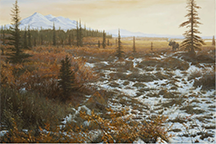 For all of us who love the outdoors the 49th state stands as the last symbol of a wild and untamed wilderness. At over 663,000 square miles and 710,0000 people, Alaska is approximately one person per square mile. I love walking across the soft tundra looking for the largest ungulate in North America, the Alaskan moose. Weighing in over 1400 pounds, this large and usually solitary member of the deer family inhabits the boreal and mixed deciduous forests feeding on grasses, roots and terrestrial shoots. They also love willows and birch trees as well as aquatic vegetation. Walking in “Moose Country” is always a pleasure as it lifts my mind, replenishes my spirit and renews my passion for living. Buy Now
For all of us who love the outdoors the 49th state stands as the last symbol of a wild and untamed wilderness. At over 663,000 square miles and 710,0000 people, Alaska is approximately one person per square mile. I love walking across the soft tundra looking for the largest ungulate in North America, the Alaskan moose. Weighing in over 1400 pounds, this large and usually solitary member of the deer family inhabits the boreal and mixed deciduous forests feeding on grasses, roots and terrestrial shoots. They also love willows and birch trees as well as aquatic vegetation. Walking in “Moose Country” is always a pleasure as it lifts my mind, replenishes my spirit and renews my passion for living. Buy Now
